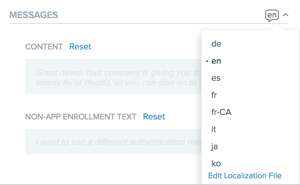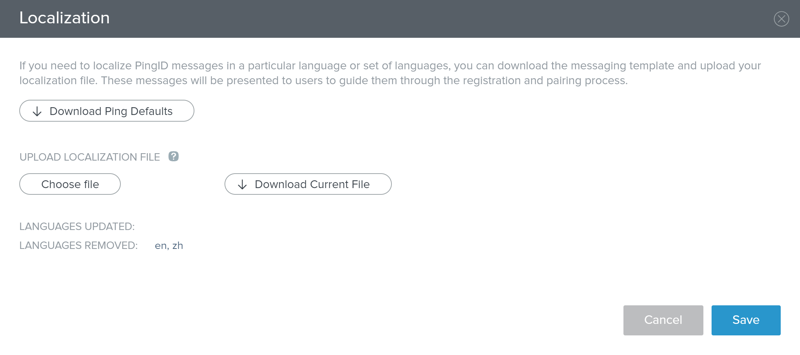Customizing the registration language files
To localize the PingID registration messages in one or more languages, download the localization messaging template, customize the languages that you want to change, and then upload them through the Admin console enrollment configuration workflow.
About this task
When uploading a localization file:
-
Attempting to upload an invalid
.zipfile structure returns the error messageFile doesn’t contain any valid localizations. -
If a localization file does not comply with the
Localization_<locale>.propertiesnaming convention, it is ignored. -
You can include instruction and maintenance files, such as
readme.txt, in the.zipfile. -
Localization files for unsupported locales are ignored.
|
Customizations that you have implemented using the Admin portal Enrollment page are reset to the default text when you customize the localization For example, if you have an online customization for English messages, and you upload a |
Steps
-
Go to Setup → PingID → Branding → Enrollment.
-
From the language selector list (
 ),
select Edit Localization File.
),
select Edit Localization File.
-
Choose a localization file to download:
Choose from:
-
Download Ping Defaults: Download a
.zipfile of the default text templates for each of the supported languages. -
Download Current File: Download the current version of the localization
.zipfile for further editing.This Download Current Fileoption is not available if the default localization file has not been edited or the PingID localization message settings were restored to the default values.

-
-
Extract the localization template
.zipfile that you downloaded.The
.zipfile includes a separate text file for each locale. -
For each language file that you want to edit, open the relevant properties file in a text editor and edit the following text content.
-
pingid.enrollment.content.description=<CONTENT message text> -
pingid.non.app.enrollment.text=<NON-APP ENROLLMENT TEXT link text>Errors in the leading
pingid.enrollment.content.description…andpingid.non.app.enrollment.text…strings, or the absence of these leading strings in the localization file, causes the affected message to revert to the default text of its locale.
-
-
Create a
.zipfile including all of the custom localization properties files.By default, files are named
Localization_<locale>.properties. The.zipfile must be a flat structure containing only the desired files, without any folder structures.The
.zipfile must include files for all locales that do not contain the default text. If you do not include the file for a specific locale, the default text is used for that locale. -
Upload the custom localization properties file:
-
In the Localization window, in the Upload Localization File section, click Choose File. Select the
.zipfile that contains the customLocalization_<locale>.propertiesfiles.Result:
A summary of the language files that will be modified shows the following:
- Languages Updated
-
Lists the language locales whose messages will be changed
- Languages Removed
-
Lists the language locales whose messages will be restored to the default messages

-
-
Click Save.